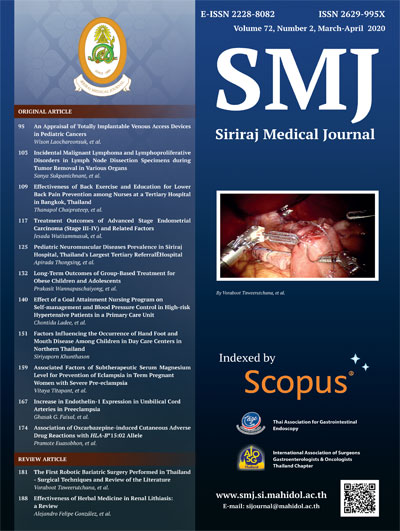An appraisal of totally implantable venous access devices in pediatric cancers
Keywords:
totally implantable venous access device, longevity, complications, pediatric cancerAbstract
Objectives: To appraise the experience of a pediatric cancer center in Thailand regarding employment of totally implantable venous access devices (TIVAD)
Methods: The records of consecutive patients aged less than 15 years diagnosed malignancy and underwent an implantation from the years 2010 to 2018 were reviewed with the main focus on effective duration and complications of the device. Changes in our practice in perioperative care were also reviewed.
Results: A total of 150 lines in 144 patients (103 hematologic malignancies and 41 solid tumors) were included with average age 6.4 years. Neck vein access was used in 62 lines, subclavian vein access in 88 lines. The median follow-up period was 973 days. Immediate complications occurred in 13 cases (9.4%). Excluding cases with death from unrelated causes, the overall TIVAD survival was 985.1 days while event-free device survival was 797.6 days. In cases of hematologic malignancies, which were the main users, 1000-day overall survival and event-free survival of TIVAD were 83.7% and 78.2%, respectively. Catheter-related infections and mechanical obstruction were the 2 most prevalent problems, occurring in 0.20 and 0.08 events/1,000 catheter days, respectively. Infection occurred in 23 patients and gram-negative bacilli were most common.Moreover,subclavian access was significantly related with infectious complications when compared to the neck vein approach.
Conclusion: A TIVAD can be used for chemotherapy longer than 3 years without serious complications. Refinement of surgical techniques and improving care process may improve the longevity of the line.
Downloads
Published
How to Cite
Issue
Section
License
Authors who publish with this journal agree to the following conditions:
Copyright Transfer
In submitting a manuscript, the authors acknowledge that the work will become the copyrighted property of Siriraj Medical Journal upon publication.
License
Articles are licensed under a Creative Commons Attribution-NonCommercial-NoDerivatives 4.0 International License (CC BY-NC-ND 4.0). This license allows for the sharing of the work for non-commercial purposes with proper attribution to the authors and the journal. However, it does not permit modifications or the creation of derivative works.
Sharing and Access
Authors are encouraged to share their article on their personal or institutional websites and through other non-commercial platforms. Doing so can increase readership and citations.











